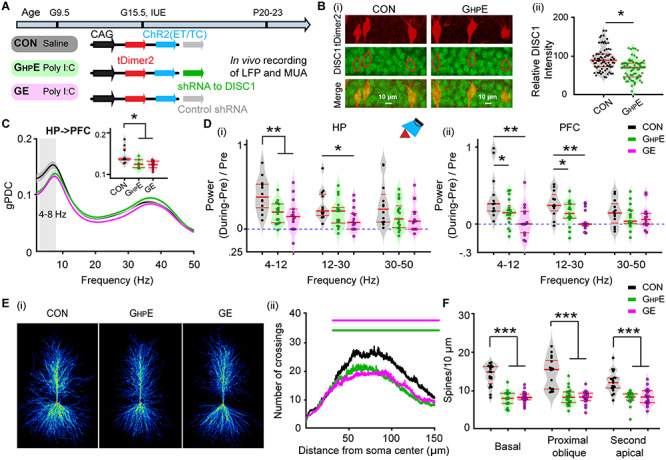Figure 5.

Patterns of prejuvenile network and neuronal firing in the CA1 area of i/vHP of immune challenged mice with whole-brain or HP-confined DISC1 suppression. (A) Timeline of experimental protocol and description of the three investigated groups of mice: CON, GHPE, and GE. For each group the constructs used for IUE to target hippocampal CA1 pyramidal neurons is specified. (B) (i) Photographs displaying the DISC1 immunoreactivity (green) in relationship with the tDimer2-expression (red) in the CA1 area of i/vHP of P21 GHPE and CON mice. (ii) Violin plots displaying the relative DISC1 immunoreactivity averaged for GHPE and CON mice at P20–P23. (C) Line plots of mean gPDC in relationship to frequency for HP➜PFC in CON (black), GHPE (green) and GE (magenta) mice. Inset, violin plots displaying gPDC when averaged for 4–8 Hz in CON, GHPE, and GE mice. (D) Violin plots displaying the hippocampal (i) and prefrontal (ii) oscillatory power averaged for different frequency bands (4–12 Hz, 12–30 Hz, 30–50 Hz) in response to ramp stimulation in HP for all investigated mice. (E) (i) Heatmap displaying an overlay of all traced dendrites of transfected CA1 pyramidal neurons in CON, GHPE, and GE mice. (ii) Graph displaying the average number of dendritic intersections within a 150 μm radius from the soma center of CA1 pyramidal neurons in CON (black, n = 21 neurons from three mice), GHPE (blue, n = 21 neurons from three mice) and GE (red, n = 21 neurons from three mice) mice. Green and magenta bars indicate significant difference (***P < 0.001) between CON and GHPE mice and between CON and GE mice, respectively. (F) Violin plots displaying the spine density on basal, proximal oblique, and second apical dendrites of CA1 pyramidal neurons from CON, GHPE, and GE mice. Single data points are represented as dots and the red horizontal bars in violin plots correspond to the median and the 25th and 75th percentiles. *P < 0.05, **P < 0.01, ***P < 0.001.
